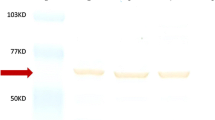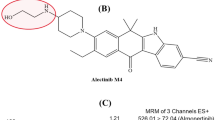Abstract
Background and Objectives
Hemangeol, approved for the treatment of proliferative infantile hemangiomas requiring systemic therapy, is metabolized by cytochrome P450 2D6 (CYP2D6), which is a highly polymorphic enzyme that metabolizes a large number of drugs. More than 100 CYP2D6 allelic variants have been reported so far, including 22 novel variants that discovered in our lab in the Chinese population. Our study aimed to probe the enzymatic activity of these variants toward hemangeol in vitro with recombinant microsomes that expressed in sf21 insect cells using a baculovirus-mediated expression system.
Methods
The wild-type CYP2D6.1 and other variants (CYP2D6.2, CYP2D6.10 and 22 novel CYP2D6 variants) were incubated with 1–200 μM hemangeol for 50 min at 37 °C. Then the products were extracted, and signal detection was performed by high-performance liquid chromatography with fluorescence detector.
Results
All of the variants exhibited changed apparent Michaelis-Menten constant (Km) or maximum velocity of the reaction (V max) values compared with that of wild-type protein. The intrinsic clearances (V max /Km) were significantly decreased by 0.37 to 42.74 %. However, CYP2D6.92 and CYP2D6.96 showed no or minimal enzymatic activity as no concentration of 4′-hydroxypropranolol was detected.
Conclusions
The comprehensive in vitro assessment of CYP2D6 variants provides significant insights into allele-specific activity towards hemangeol in vivo.


Similar content being viewed by others
References
Ma X, Chang M, Ouyang T, Xu D, Xu M, Ke J, et al. Combination of propranolol and sclerotherapy for treatment of infantile parotid hemangiomas. Int J Clin Exp Med. 2015;8(7):10865–74.
Sethuraman G, Yenamandra VK, Gupta V. Management of Infantile Hemangiomas: current Trends. J Cutaneous Aesthetic Surg. 2014;7(2):75–85.
Liang MG, Frieden IJ. Infantile and congenital hemangiomas. Semin Pediatr Surg. 2014;23(4):162–7.
Cuccaro P, Rapacciuolo A, Vitiello R, di Pietro E, Montaldo P, Esposito F, et al. Propranolol for severe hemangioma of infancy. Journal of cardiovascular medicine (Hagerstown, Md). 2011;12(1):5.
Leaute-Labreze C, Dumas de la Roque E, Hubiche T, Boralevi F, Thambo JB, Taieb A. Propranolol for severe hemangiomas of infancy. New Engl J Med. 2008;358(24):2649–51.
Oksiuta M, Matuszczak E, Debek W, Dzienis-Koronkiewicz E, Hermanowicz A, Tylicka M. Treatment of problematic infantile hemangiomas with propranolol: a series of 40 cases and review of the literature. Postepy Hig Med Dosw (Online). 2014;68:1138–44.
Drolet BA, Frommelt PC, Chamlin SL, Haggstrom A, Bauman NM, Chiu YE, et al. Initiation and use of propranolol for infantile hemangioma: report of a consensus conference. Pediatrics. 2013;131(1):128–40.
Fette A. Propranolol in use for treatment of complex infant hemangiomas: literature review regarding current guidelines for preassessment and standards of care before initiation of therapy. Sci World J. 2013;2013:850193.
Tan CE, Itinteang T, Leadbitter P, Marsh R, Tan ST. Low-dose propranolol regimen for infantile haemangioma. J Paediatr child Health. 2015;51(4):419–24.
Albuquerque JC, Magalhaes RA, Felix JA, Bastos MV, Fontenele JB, Trompieri NM, et al. Treatment of children and adolescents with hemangioma using propranolol: preliminary results from a retrospective study. Sao Paulo medical journal. Rev Paul Med. 2014;132(1):48–54.
Andersen IG, Rechnitzer C, Charabi B. Effectiveness of propanolol for treatment of infantile haemangioma. Danish Med J. 2014;61(2):A4776.
Narimatsu S, Nakata T, Shimizudani T, Nagaoka K, Nakura H, Masuda K, et al. Regio- and stereoselective oxidation of propranolol enantiomers by human CYP2D6, cynomolgus monkey CYP2D17 and marmoset CYP2D19. Chem Biol Interact. 2011;189(3):146–52.
Huang CW, Lai ML, Lin MS, Lee HL, Huang JD. Dose-response relationships of propranolol in Chinese subjects with different CYP2D6 genotypes. J Chin Med Assoc JCMA. 2003;66(1):57–62.
Zhou SF. Polymorphism of human cytochrome P450 2D6 and its clinical significance: part II. Clin Pharmacokinet. 2009;48(12):761–804.
Zanger UM, Raimundo S, Eichelbaum M. Cytochrome P450 2D6: overview and update on pharmacology, genetics, biochemistry. Naunyn-Schmiedeberg’s Arch Pharmacol. 2004;369(1):23–37.
Ingelman-Sundberg M, Sim SC, Gomez A, Rodriguez-Antona C. Influence of cytochrome P450 polymorphisms on drug therapies: pharmacogenetic, pharmacoepigenetic and clinical aspects. Pharmacol Ther. 2007;116(3):496–526.
http://www.cypalleles.ki.se/cyp2d6.htm. Accessed 9 Dec 2014.
Zhou SF, Di YM, Chan E, Du YM, Chow VD, Xue CC, et al. Clinical pharmacogenetics and potential application in personalized medicine. Curr Drug Metab. 2008;9(8):738–84.
Tateishi T, Chida M, Ariyoshi N, Mizorogi Y, Kamataki T, Kobayashi S. Analysis of the CYP2D6 gene in relation to dextromethorphan O-demethylation capacity in a Japanese population. Clin Pharmacol Ther. 1999;65(5):570–5.
Qin S, Shen L, Zhang A, Xie J, Shen W, Chen L, et al. Systematic polymorphism analysis of the CYP2D6 gene in four different geographical Han populations in mainland China. Genomics. 2008;92(3):152–8.
Lee SJ, Lee SS, Jung HJ, Kim HS, Park SJ, Yeo CW, et al. Discovery of novel functional variants and extensive evaluation of CYP2D6 genetic polymorphisms in Koreans. Drug Metab Disp Biol Chem. 2009;37(7):1464–70.
Dai DP, Geng PW, Wang SH, Cai J, Hu LM, Hu GX, et al. In Vitro Functional Assessment of 22 Newly Identified CYP2D6 Allelic Variants in the Chinese Population. Basic Clin Pharmacol Toxicol. 2015;117(1):39–43.
de Graaf M, Breur JM, Raphael MF, Vos M, Breugem CC, Pasmans SG. Adverse effects of propranolol when used in the treatment of hemangiomas: a case series of 28 infants. J Am Acad Dermatol. 2011;65(2):320–7.
Langley A, Pope E. Propranolol and central nervous system function: potential implications for paediatric patients with infantile haemangiomas. Br J Dermatol. 2015;172(1):13–23.
Kong LM, Qian MR, Hu HH, Xu SY, Yu LS, Jiang HD, et al. Comparison of catalytical activity and stereoselectivity between the recombinant human cytochrome P450 2D6.1 and 2D6.10. Pharmazie. 2012;67(5):440–7.
Guengerich FP, Hanna IH, Martin MV, Gillam EM. Role of glutamic acid 216 in cytochrome P450 2D6 substrate binding and catalysis. Biochemistry. 2003;42(5):1245–53.
Dai DP, Geng PW, Wang SH, Cai J, Hu LM, Nie JJ, et al. In vitro functional assessment of 22 newly identified CYP2D6 allelic variants in the Chinese population. Basic Clin Pharmacol Toxicol. 2015;117(1):39–43.
Qian JC, Xu XM, Hu GX, Dai DP, Xu RA, Hu LM, et al. Genetic variations of human CYP2D6 in the Chinese Han population. Pharmacogenomics. 2013;14(14):1731–43.
Acknowledgments
The authors thank the members of the Beijing Institute of Geriatrics of the Ministry of Health for their advice and assistance. This work was supported by the Ministry of Health of the People’s Republic of China (201302008).
Author information
Authors and Affiliations
Corresponding authors
Ethics declarations
Conflict of interest
No conflicts of interest have been declared.
Rights and permissions
About this article
Cite this article
Liang, B., Zhan, Y., Huang, X. et al. Effect of 22 Novel Cytochrome P450 2D6 (CYP2D6) Variants Found in the Chinese Population on Hemangeol Metabolism In Vitro. Eur J Drug Metab Pharmacokinet 41, 759–765 (2016). https://doi.org/10.1007/s13318-015-0307-0
Published:
Issue Date:
DOI: https://doi.org/10.1007/s13318-015-0307-0




